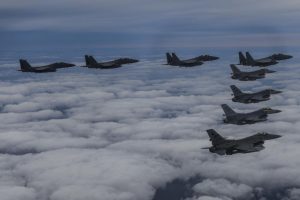North Korea launched two short-range ballistic missiles (SRBMs) toward the waters off its east coast, South Korea’s Joint Chiefs of Staff (JCS) said on Thursday.
The first missile flew about 350 km with an altitude of 60 km, and the second missile flew about 800 km with an altitude of 80 km. Both missiles were launched from the Samseok area of Pyongyang, the North Korean capital, between 6:01 a.m. to 6:23 a.m., the JCS said.
North Korea has normally launched ballistic missiles from the Sunan area in Pyongyang. Thursday’s missile launch was carried out from a new area, showing the North’s capability to launch missiles from previously undisclosed locations.
It is the North’s sixth round of ballistic missile tests within two weeks, its 39th ballistic missile launch this year, and the 10th since South Korean President Yoon Suk-yeol took office in May.
“(We) will closely take care of the life and safety of the people on the basis of the powerful South Korea-U.S. alliance and the South Korea-U.S.-Japan trilateral military cooperation,” Yoon told reporters on his way to work on Thursday.
The National Security Council held a meeting after the North Korean missile launch was detected. The members of the NSC, including the national security advisor and the defense and foreign ministers, strongly condemned the launch and reaffirmed strengthening the South Korea-U.S. military readiness posture and the South Korea-U.S.-Japan trilateral cooperation.
Thursday’s launch came two days after North Korea launched an intermediate-range ballistic missile (IRBM), a suspected Hwasong-12 missile, over Japan. Japanese residents in the northern regions of Hokkaido Island and Aomori prefecture were warned to seek shelter after the Japanese authorities detected the North Korean missile flying over its mainland. Japanese Prime Minister Kishida Fumio strongly condemned the missile launch, calling it “very violent behavior.” It was the first time North Korea had launched a missile over Japan since 2017.
As a corresponding measure, South Korea conducted a live-fire drill with the United States about 16 hours after the North’s IRBM launch on Tuesday. However, a South Korean Hyunmoo-2 SRBM launched during the drill failed to fly toward the target and instead fell onto a golf course in the military airbase in Gangnueng city, on the northeast coast of South Korea, according to the military and media reports.
No injuries were reported but local residents were alarmed by the malfunction. They criticized the military, complaining that they did not have enough information about the drill beforehand. According to media reports, some residents were not informed as to what caused the explosion near their residences by either their city officials or the military in a timely manner. In a parliamentary audit on the JCS on Thursday, Kim Seung-kyum, the chairman of the JCS, publicly apologized over his office’s failure to provide information on the accident appropriately.
During the live-fire drill with South Korea, the United States redeployed its nuclear-powered aircraft carrier USS Ronald Reagan in the waters off the South’s east coast on Wednesday. The USS Ronald Reagan was also deployed for the joint military exercise with South Korea last week, its first deployment in the region since 2017. In the wake of the North’s IRBM launch on Tuesday, South Korea, the United States, and Japan conducted a trilateral defensive military exercise on Thursday simulating tracking and detecting the North’s missiles, according to media reports.
On Wednesday, the United Nations Security Council held a meeting upon the request of the United States to discuss North Korea’s IRBM launch. The state members of the UNSC did not discuss the North’s SRBM launches on Thursday, as they took place about two hours after the session began.
“These launches violate multiple Security Council resolutions and pose a threat to not only the region, but to the entire international community,” Linda Thomas-Greenfield, the U.S. ambassador to the U.N., said.
In a joint press briefing to deliver a joint statement drafted by the U.S. along with eight countries, including South Korea and Japan, Thomas-Greenfield also said, “We will not stay silent as the DPRK works to undermine the global nonproliferation regime and threaten the international community.” (DPRK is an acronym of North Korea’s official name: Democratic People’s Republic of Korea.)
As no official joint statement from the UNSC was issued after the meeting, it is believed that China and Russia again vetoed the U.S.-led efforts to respond to the North’s missile threats.
Geng Shuang, China’s deputy permanent representative to the United Nations, signaled during the meeting that the North’s missile launches were carried out due to the recent military exercises conducted by South Korea, the United States, and Japan in the region.
Korean Central News Agency (KCNA), one of the main state-controlled media outlets in North Korea, published a press statement from its Foreign Ministry on Thursday.
“The DPRK Foreign Ministry strongly condemns the U.S. and its some satellites for unwarrantedly referring to the UNSC the just counteraction measures of the Korean People’s Army against South Korea-U.S. joint drills escalating the military tensions on the Korean Peninsula,” the North’s Foreign Ministry said in its press statement.
It was the first official confirmation from North Korea that its recent series of ballistic missile launches were designed to respond to the South Korea-U.S. joint military exercises – as Shuang mentioned during the UNSC meeting on Wednesday.
“The DPRK is watching the U.S. posing a serious threat to the stability of the situation on the Korean Peninsula and in its vicinity by redeploying the carrier task force in the waters off the Korean Peninsula.” the North’s Foreign Ministry said.
More and more provocative “tit-for-tat” measures are likely come from the two Koreas and the United States in the coming weeks. South Korea’s intelligence agency has warned that North Korea could conduct a nuclear test between October 17 to November 7.

































